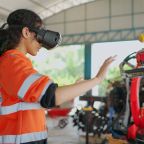The 70:20:10 Model for Learning and Development was developed from research at the Center for Creative Leadership (CCL) in the 1980s and suggests that the most effective learning comes from on-the-job experiences (70%), social interactions (20%), and formal training such as classroom training or online courses (10%).
What is the 70:20:10 Model?
The 70:20:10 Model for Learning and Development is a commonly used formula within the training profession. The model suggests that 70% of the average person’s knowledge is obtained by doing on-the-job experiences, 20% from social sources such as interactions with others, and 10% from formal training and events. Origins of the model date back to the 1980s when researchers McCall, Lombardo, and Morrison were interested in explaining the key developmental experiences of successful leaders.
The model describes the optimal sources of learning, suggesting that individuals obtain knowledge, skills, and abilities in their jobs mostly when doing hands-on experiences. They found that learners obtain knowledge best when doing hands-on activities because it enables them to discover and refine their job-related skills, make informed decisions, and tackle challenges at work. Another important factor of the model is that employees learn from their mistakes and receive immediate feedback on their performance.
How to Apply the 70:20:10 Model
The model is often used to define the ideal balance for how to provide corporate learning and staff development opportunities. The model is considered to be of greatest value as a general guideline for organizations looking to maximize the effectiveness of their learning and development programs through other activities and inputs. By applying this model to your learning and development programs, you can ensure that your organization provides adequate learning and development opportunities catered to your employees’ needs.
Part of what makes the 70:20:10 Model so attractive is that it generally makes sense on the surface as it represents a common-sense structure of developmental experiences of employees. Learning professionals should apply this model to their workforce by creating a controlled environment where learners can make choices and face consequences — both good and bad. Proper performance support is key throughout the application of this model to ensure that learners feel supported and guided at work.
Moving Past the 70:20:10 Model
Some professionals argue that the effectiveness of the model is hindered because it originated during a time when the internet and modern technologies weren’t as prevalent. Unlike decades ago, the world is now heavily influenced by powerful web searches, social media, and cell phones.
Modern learning and development tools and tactics are certainly richer than what was available before, so it makes sense that today’s training is heavily shaped by the influx of technology in the workplace. Some argue that while the model’s ratios may not reflect current learning and development practices, the model is mostly still consistent with the developmental experiences of employees.
The onslaught of learning technologies in the past couple of decades has altered the training industry’s views of the 70:20:10 Model. Some training professionals contend that the model doesn’t reflect the market’s fast-growing emphasis on informal learning and the constant evolution of technology. Whether you agree or disagree, the model continues to be used as a guideline on how to employ various developmental experiences.








